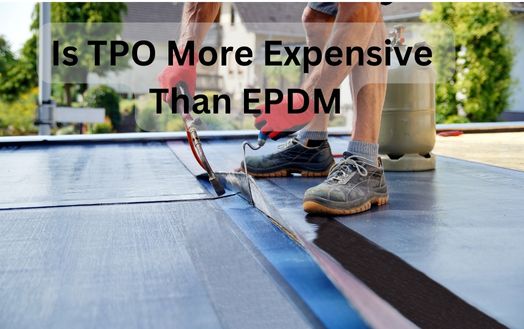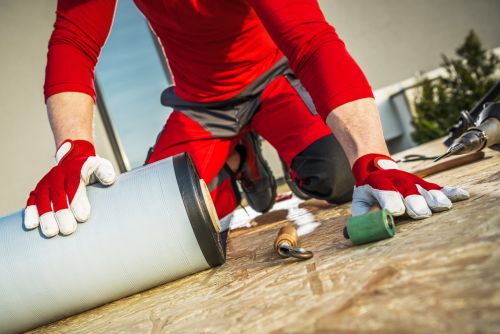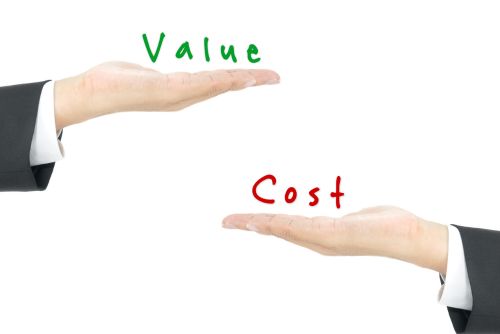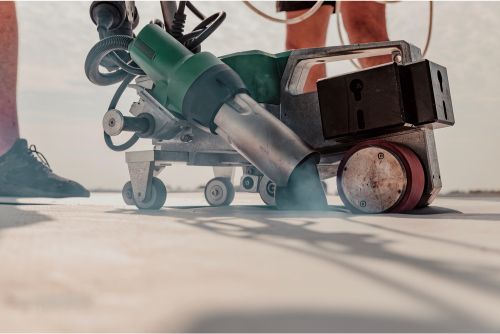
When it comes to choosing the right roofing material for your property, durability, longevity, and cost are some of the most important factors to consider. TPO (thermoplastic polyolefin) and EPDM (ethylene propylene diene monomer) are two popular options in the roofing industry. Both materials offer their own set of benefits and drawbacks, and understanding the differences between them can help you make an informed decision. In this blog, we will compare, is TPO more expensive than EPDM, delve into their advantages and potential drawbacks, discuss the cost factors, and evaluate their longevity, durability, maintenance requirements, energy efficiency, and environmental impact. By the end, you will have a better understanding of whether TPO or EPDM roofing is the best choice for your property.
TPO roofing is a type of roofing membrane that combines EPDM rubber and polypropylene, resulting in a durable roofing system. Its synthetic rubber material and seam strength make it a popular choice among roofing professionals. TPO roofs are known for their durability, with formulations designed to prevent shrinkage, leaks, and potential adhesives issues. The thickness of TPO roofing, measured in mils, contributes to its longevity, making it a suitable option for various roofing projects. Property owners often favor TPO roofing because of its fewer seams, wider rolls, and professional track record in the roofing industry.
TPO roofing, also known as thermoplastic polyolefin roofing, is a type of roofing membrane that combines ethylene propylene diene monomer (EPDM) rubber and polypropylene. This combination creates a durable, weather-resistant roofing material. TPO roofs consist of a single-ply roofing membrane that is typically white, allowing it to reflect UV rays and keep the building cool. The membrane thickness of TPO roofing is typically measured in mils, with options ranging from 45 mils to 90 mils. The thicker the membrane, the more durable and long-lasting the roofing system will be. TPO roofing membranes are available in wide rolls, reducing the number of seams required during installation. This results in fewer opportunities for commercial leak repair NJ, making TPO roofing a popular choice among property owners and roofing professionals alike.
TPO roofing offers several advantages that make it a popular choice for commercial buildings and property owners. Here are some of the key advantages of TPO roofing:
When considering TPO roofing, it’s essential to be mindful of potential drawbacks. Installation must be precise to avoid issues such as shrinkage, leaks, and fastener problems impacting longevity and insulation. Property owners should weigh the upfront investment along with concerns about seams, adhesives, and membrane thickness. Understanding these cons is crucial for both homeowners and commercial property owners. It’s imperative that commercial roofing contractors NJ communicate these potential drawbacks, addressing any worries about seam strength, adhesives, and overall longevity.

EPDM, which stands for ethylene propylene diene terpolymer, is a type of synthetic rubber used for various applications, including roofing. It is highly regarded for its durability, low maintenance, and weather resistance. EPDM roofing is commonly used for both commercial and residential flat roofs due to its flexibility and ease of installation. Its exceptional waterproofing properties make it an ideal choice for buildings with flat or low-sloping roofs. The material’s longevity and cost-effectiveness also add to its appeal as a roofing solution.
EPDM roofing, also known as ethylene propylene diene monomer, is a synthetic rubber membrane commonly used in flat roof construction due to its exceptional durability and long lifespan. With wide rolls that feature fewer seams, this type of roofing offers excellent insulation and has a proven track record of resilience in commercial buildings. Its resistance to UV rays, extreme weather conditions, and energy efficiency make it a top choice for property owners. Professional roofing contractors highly recommend EPDM roofing for its seam strength, synthetic rubber material, and suitability for commercial flat roof systems. Additionally, the black color of EPDM roofing membranes contributes to energy efficiency and effective insulation, making it a popular option for various roofing needs.
EPDM roofing membranes, renowned for their synthetic rubber material and strong seams, offer long-lasting durability in commercial buildings. With proven insulation, fewer seams, and wide rolls, EPDM roofs provide energy efficiency and resilience for property owners. The material’s resistance to UV rays, harsh weather conditions, and energy-saving features make EPDM roofing a preferred choice for commercial flat roof systems. Professional roofing contractors endorse EPDM roofing for its synthetic rubber material, seam strength, and proven durability in commercial buildings. Its track record, insulation properties, and suitability for cold climates, commercial buildings, and flat roof systems make it the top option for roofing projects.
EPDM roofing, while offering numerous benefits, requires careful installation to avoid potential issues related to seams, adhesives, and membrane thickness. Property owners should be aware of the upfront investment required, along with any cons associated with seams, adhesives, or membrane durability. Understanding the potential cons, including shrinkage, leaks, and fasteners problems, is crucial for both homeowners and commercial property owners. Professional roofing contractors play a vital role in informing property owners about the potential cons of EPDM roofing, addressing their concerns related to seam strength, adhesives, and longevity.

When considering the cost of TPO and EPDM roofing, it’s essential to factor in installation, material costs, and long-term expenses. Installation charges for TPO may vary due to welding equipment requirement, unlike EPDM, which can be ballasted or fully adhered. It’s important to note that long-term value should also be considered when evaluating the cost-effectiveness of these roofing materials. Let this article discuss more, is TPO more expensive than EPDM?
When considering TPO roofing costs, property owners should consider several factors, such as materials, installation, and square footage requirements. The long-term cost-effectiveness of TPO roofing is influenced by its lifespan, energy efficiency, and insulation properties. Professional roofing contractors can offer a detailed cost breakdown, taking into account system options and longevity. The overall cost of TPO roofing can be affected by the type of roof, commercial roofing company NJ expertise, and material options. Property owners need to understand the cost, energy efficiency, and insulation differences between TPO and EPDM roofing to make informed decisions.
The cost of EPDM roofing varies based on square footage, affected by membrane thickness and the type of roofing system. Factors such as EPDM roofing options, contractor expertise, track record, and industry standards also impact overall costs. Moreover, different types of EPDM roofs, formulations, and adherence to roofing industry standards influence pricing. Understanding these factors helps in making an informed decision when considering EPDM roofing.

When considering the longevity and durability of TPO and EPDM, it’s essential to recognize that TPO roofs usually have a lifespan of 22-30 years. However, EPDM roofing typically lasts around 20-25 years. As for durability, TPO is more resistant to punctures and tears, while EPDM is known for its flexibility and ability to withstand extreme temperatures. The choice between these two largely depends on specific environmental factors and maintenance considerations. Both PVC roof types offer varying degrees of longevity and durability, making them suitable for different applications and climates.
TPO roofing systems offer a noteworthy advantage in terms of longevity compared to other roofing types. Property owners can benefit from the longer lifespan of TPO roofing, especially when considering the specific requirements of their roofing project. Proper insulation enhances the durability of TPO roofing, enabling it to withstand extreme weather conditions. Professional installation further contributes to extending the lifespan of TPO roofing systems, making them a reliable choice for long-term use. In the long run, minimal commercial roof repair NJ is needed.
EPDM roofing membranes offer exceptional durability, requiring fewer adhesives and reducing the risk of leaks. The synthetic rubber in EPDM membranes ensures superior seam strength, making it a great choice for long-lasting roofing solutions. Its durability is especially beneficial for homeowners in cold climates, and its longevity makes it a popular option among roofing professionals. With such resilience, EPDM roofing stands out as a reliable and durable choice for any property.
When it comes to maintenance, PVC roofs, including TPO and EPDM, require regular care and attention to ensure longevity. Maintenance for PVC roofing involves inspecting seams, checking for punctures, and clearing debris. Similarly, EPDM roofs need diligent examination for cuts, tears, and abrasions, along with keeping the surface clean and free of debris and maintain commercial roof replacement NJ. Routine maintenance is essential in prolonging the life of both PVC roof types, ensuring they remain durable and reliable over time.
Regular inspection of TPO roof seams is crucial to identify potential leaks and prevent water damage. Professional attention is necessary to prevent shrinkage and seam issues, ensuring the integrity of the roofing system. Routine inspections and maintenance help in preventing membrane shrinkage and seam leaks, prolonging the life of the TPO roof. It is essential to check TPO roofing adhesives and fasteners regularly to maintain the roof’s effectiveness. Professional roofing contractors play a key role in ensuring the insulation and adhesives of TPO roofs remain intact, enhancing the roof’s longevity and performance.
To ensure the longevity and durability of EPDM roofing, professional inspection of seams and fasteners is essential. Regular checks of the EPDM roof membrane can prevent leaks and adhesion issues, while also avoiding shrinkage through professional care. It’s important to maintain EPDM roof adhesives and fasteners regularly to prevent any potential issues. By conducting these maintenance tasks, you can ensure the integrity and performance of your EPDM roof.

When considering energy efficiency, both TPO and EPDM roofing offer significant advantages. TPO roofs are known for their reflective properties, reducing heat absorption and cooling costs. On the other hand, EPDM offers excellent insulation, minimizing heat loss during colder months. Both PVC and polyvinyl chloride materials contribute to the energy-efficient nature of these roofing solutions, providing durability and sustainability. When evaluating flooring options, these roofing materials stand out for their energy-saving features, making them a practical choice for environmentally-conscious consumers.
TPO roofing is highly energy efficient, making it ideal for commercial buildings. Its insulation properties help reduce energy costs, resulting in lower bills for property owners. The synthetic rubber material used in TPO roofing also contributes to its energy efficiency. Proper installation by a professional roofing contractor ensures maximum energy efficiency.
EPDM roofing’s energy efficiency stems from its exceptional insulation properties, benefiting property owners in extreme weather conditions. The synthetic rubber material of EPDM roofing contributes to its energy efficiency, especially when installed in white or light colors to optimize energy savings. Professional contractors play a key role in enhancing EPDM roofing’s energy efficiency through proper membrane installation, ensuring maximum performance. This makes EPDM roofing a favorable choice for energy-conscious individuals seeking long-term efficiency and environmental sustainability.
When considering the environmental impact of TPO and EPDM roofing, it’s important to note that TPO is a type of single-ply roofing membrane made from ethylene propylene rubber and polyethylene. It is most commonly used as a roofing material for commercial buildings, as it is energy-efficient, recyclable, and has a lower environmental impact compared to PVC roof options. On the other hand, EPDM, also known as ethylene propylene diene monomer, is a type of synthetic rubber that is highly durable and resistant to environmental factors. EPDM roofing is considered an environmentally friendly option due to its durability, longer lifespan, and recyclable nature. The choice between TPO and EPDM roofing ultimately depends on the specific environmental considerations and requirements of the project.
When considering TPO roofing, environmental factors play a crucial role. TPO membranes are ideal for commercial buildings, especially in cold climates, as they offer superior energy efficiency and insulation for extreme weather conditions. It’s essential to engage a reputable roofing contractor for a successful TPO roofing project. Additionally, TPO roofing is a durable option suitable for flat roof applications, ensuring longevity and better protection against leaks due to fewer seams.
EPDM roofing systems stand out as a favored choice for flat roof installations, primarily due to their exceptional durability. The synthetic rubber material of EPDM membranes ensures a longer lifespan, making it an ideal option for property owners seeking sustainable roofing solutions. Moreover, EPDM membranes provide superior insulation, effectively reducing energy consumption in buildings. The remarkable durability and resistance to extreme weather make EPDM systems a reliable and environmentally-friendly choice for various roofing projects, particularly when installed by professional contractors specializing in EPDM roofing installations.

When evaluating TPO and EPDM roofing, the choice ultimately comes down to the material used. TPO roofs boast thermoplastic polyolefin, offering superior energy efficiency, while EPDM roofs feature ethylene propylene diene monomer, excelling in durability against extreme weather conditions. Property owners should carefully assess their specific needs to determine the best fit. Professional roofing companies are invaluable resources for expert advice on selecting the ideal roofing system for commercial or residential buildings.
When comparing TPO and EPDM roofing, it’s important to consider the value for money they offer. TPO roofing provides cost-effective installation for commercial buildings, while EPDM roofing offers longevity and durability. The choice depends on specific needs and guidance from professional contractors. So, is TPO more expensive than EPDM?
In conclusion, when it comes to choosing between TPO and EPDM roofing, there are several factors to consider. TPO roofing offers advantages such as energy efficiency, ease of installation, and a wide range of color options. However, it may have potential drawbacks like a shorter lifespan and higher upfront costs. On the other hand, EPDM roofing is known for its durability, cost-effectiveness, and long lifespan. It may have issues such as limited color options and a higher chance of punctures. Ultimately, the decision should be based on your specific needs, budget, and preferences. Consult with a professional roofing contractor to determine which option provides the best value for your money and meets your requirements.